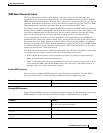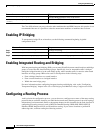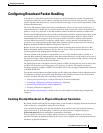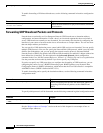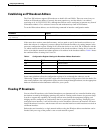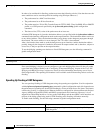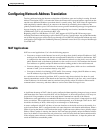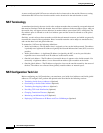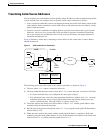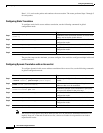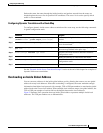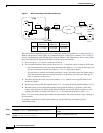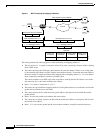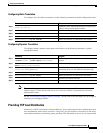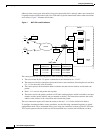
Configuring IP Addressing
Configuring Network Address Translation
IPC-37
Cisco IOS IP Configuration Guide
Translating Inside Source Addresses
You can translate your own IP addresses into globally unique IP addresses when communicating outside
of your network. You can configure static or dynamic inside source translation as follows:
• Static translation establishes a one-to-one mapping between your inside local address and an inside
global address. Static translation is useful when a host on the inside must be accessible by a fixed
address from the outside.
• Dynamic translation establishes a mapping between an inside local address and a pool of global
addresses. An access-list or a route-map can be specified for dynamic translations. Route maps
allow you to match any combination of access-list, new-hop IP address, and output interface to
determine which pool to use.
Figure 4 illustrates a router that is translating a source address inside a network to a source address
outside the network.
Figure 4 NAT Inside Source Translation
The following process describes inside source address translation, as shown in Figure 4:
1. The user at host 1.1.1.1 opens a connection to host B.
2. The first packet that the router receives from host 1.1.1.1 causes the router to check its NAT table:
–
If a static translation entry was configured, the router goes to Step 3.
–
If no translation entry exists, the router determines that Source-Address (SA) 1.1.1.1 must be
translated dynamically, selects a legal, global address from the dynamic address pool, and
creates a translation entry. This type of entry is called a simple entry.
3. The router replaces the inside local source address of host 1.1.1.1 with the global address of the
translation entry and forwards the packet.
4. Host B receives the packet and responds to host 1.1.1.1 by using the inside global IP Destination-
Address (DA) 2.2.2.2.
5. When the router receives the packet with the inside global IP address, it performs a NAT table
lookup by using the inside global address as a key. It then translates the address to the inside local
address of host 1.1.1.1 and forwards the packet to host 1.1.1.1.
1.1.1.2
Host B
9.6.7.3
1.1.1.1
Internet
Inside
Inside
interface
Outside
interface
Outside
1.1.1.2
1.1.1.1
2.2.2.3
2.2.2.2
Inside Local
IP Address
NAT table
Inside Global
IP Address
1
3
S4790
SA
2.2.2.2
5
DA
1.1.1.1
SA
1.1.1.1
4
DA
2.2.2.2
2



